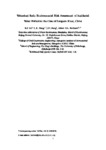Watershed-Scale Environmental Risk Assessment of Accidental Water Pollution: The Case of Laoguan River, China
| dc.contributor.author | Liu, RZ | |
| dc.contributor.author | Zhang, K | |
| dc.contributor.author | Zhang, ZJ | |
| dc.contributor.author | Borthwick, Alistair | |
| dc.date.accessioned | 2021-08-22T16:15:29Z | |
| dc.date.available | 2021-08-22T16:15:29Z | |
| dc.date.issued | 2018-06-01 | |
| dc.identifier.issn | 1726-2135 | |
| dc.identifier.issn | 1684-8799 | |
| dc.identifier.uri | http://hdl.handle.net/10026.1/17694 | |
| dc.description.abstract |
Although co-existing sources of chemicals pose major cumulative environmental threats to watersheds, few risk asse- ssments have specifically tackled the accidental chemical pollution of rivers at watershed-scale. Herein, a Watershed-scale Accidental Pollution Risk Assessment (WAPRA) method was constructed which applied a risk ranking procedure to the whole watershed, and was based on watershed-scale stressors, exposures to and effects of water accidental pollution risk (e.g., sudden occurrences, waterway spread, and acute consequences). Multi-criteria analysis and instantaneous water quality models were used to refine the risk ranking procedure within the framework of a Relative Risk Model (RRM), a regional-scale ecological risk assessment approach. The study area comprised the Laoguan River, a tributary watershed of the Danjiangkou Reservoir, which will eventually feed into the South-to-North Water Diversion Project in China. The resultant map shows that risk is higher in the upstream and downstream reaches, and lower in the middle reaches. The map also indicates that the greatest threat to water quality arises from the upstream heavy metal mine tailings ponds. Sensitivity and uncertainty analyses were performed to validate the robustness of the WAPRA method. | |
| dc.format.extent | 87-96 | |
| dc.language.iso | en | |
| dc.publisher | International Society for Environmental Information Science (ISEIS) | |
| dc.title | Watershed-Scale Environmental Risk Assessment of Accidental Water Pollution: The Case of Laoguan River, China | |
| dc.type | journal-article | |
| dc.type | Journal Article | |
| plymouth.issue | 2 | |
| plymouth.volume | 31 | |
| plymouth.publication-status | Published online | |
| plymouth.journal | Journal of Environmental Informatics | |
| dc.identifier.doi | 10.3808/jei.201600346 | |
| plymouth.organisational-group | /Plymouth | |
| plymouth.organisational-group | /Plymouth/Faculty of Science and Engineering | |
| plymouth.organisational-group | /Plymouth/Users by role | |
| plymouth.organisational-group | /Plymouth/Users by role/Academics | |
| dc.identifier.eissn | 1684-8799 | |
| dc.rights.embargoperiod | Not known | |
| rioxxterms.versionofrecord | 10.3808/jei.201600346 | |
| rioxxterms.licenseref.uri | http://www.rioxx.net/licenses/all-rights-reserved | |
| rioxxterms.type | Journal Article/Review |


